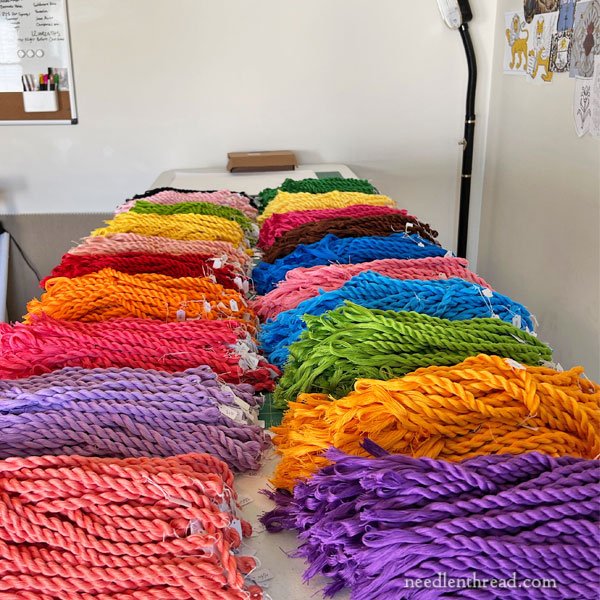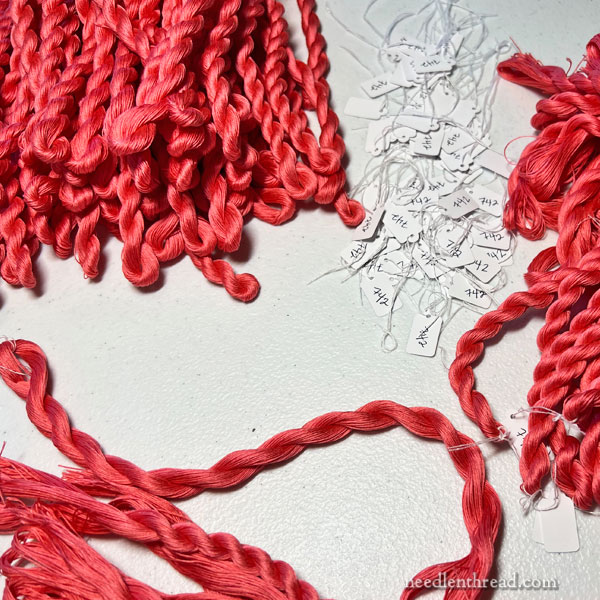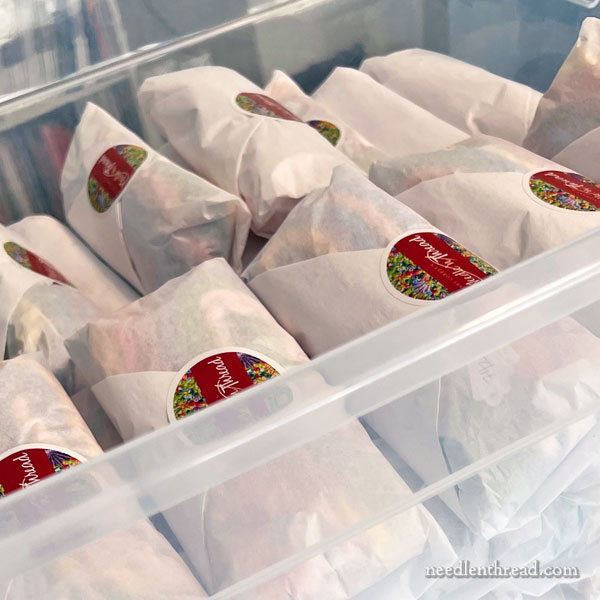This floche Garden-Bright thread pack that we released last month was a pretty big hit! I really thought we would have the threads in stock for a while, but they sold out quickly, and I’ve been compiling an advanced notice list for those interested in the next batch. (If you want to be on that list, please contact me to let me know – I’ll add you!)
We started preparing some new floche packs right away.
It’s a long and grueling process, but I think it’s worth it!

Because floche comes in such huge hanks with a retail price tag that reflects the quantity of the thread, it’s hard to build a nice collection of floche with a wider color range without breaking the bank.
Breaking the hanks down and making them available in a grouped collection of colors seems to me like a good way to get a quantity of this lovely thread in people’s hands, so that they can experience stitching with a wide and fun range of colors.
The preparation of the floche packs happens in several steps:
First, we open up each hank of a single color into a large circle, and we cut that hank at the point where it begins and ends.
Then, we divide the resulting very long bunch of threads into thirds, counting the numbers of strands, and we lay these out over the work table.
Then, we take each third of a hank and twist it until there’s enough twist in the thread that the folded thread doubles on itself, into a twist that keeps the floche tidier than it would be, if it were packaged in loose swaths.

Tagging the twists is my favorite part.
Number tags are written out by hand and looped onto each twist at the halfway point where it folds.
We toyed with printed number tags, thinking it might be faster, but it is neither faster nor more economical. We can whip out the hand-written number tags very quickly on pre-made tags.
At one point, I was preparing the hand-written tags ahead of time, so that we could go quickly from creating the twists to tagging the colors. But I mixed up one of the colors and accidentally tagged a whole batch of one color with the wrong number. This would be a disastrous mistake, if I hadn’t caught it. Everyone would suffer under the impression that the pink above was 742 – which it’s not. It’s a pink in the 800 DMC range. 742 is yellow! Aaaargh!
Now, we only prepare tags as each single-color batch is ready to twist. This way, we ensure there’s no mistake on the colors.
I’m working on other tagging solutions to implement in the future, but for now, these little tags work well and they do what they’re supposed to do – they let you know the color number.
You can always “repackage” your thread in your favorite organizational packaging once you get it, if you don’t prefer twists or if your twists break down too much as you use up the thread. I store my threads in these Bisley cabinets that I’ve written about before, but if I’mm using floche on a project that I’m toting around, I will normally put the individual colors of floche into small floss bags with the color number on the bag. Floche is a soft thread, a little more delicate than most cotton threads, and I like to keep it protected.

The final step is gathering one of each of the twists that makes up the color collection and bundling them all into a neatly wrapped tissue paper package with a sticker.
They look like plump floche burritos, almost good enough to eat.
These go into bins on the stock shelves until time to ship them to you.
So that’s what goes into floche color packs. They take quite a bit of time to prepare – but even with the time involved, they do end up being a much more economical way for the stitcher to acquire a good collection of colors of floche, with plenty of thread in each twist for a good number of projects.
That’s mostly what we’ve been doing lately in the studio. These packs are not quite ready to go yet, but I’ll let you know when they are.
And, for those who have asked, yes, we will have other collections available in the future! We have already started on two “vintage” color collections that will certainly appeal to those who like stitching primitive designs, or who just want a range of deeper, more muted colors to play with, too.
It’s a great job! After all, who doesn’t like playing with thread?!







Vintage colors – yes, please!
Please add me to the I-Want-Floche list! Thank you!
Hi, Jan – Can you drop me an email for this? Thanks a bunch!
What a lot of work! I hope you are using a drill or some other tool to do all that twisting and not doing it all by hand.
Those threads out on the table are gorgeous.
I would love to see your wares distributed to Europe. Hell. I’d even distribute for you. Alas. These look absolutely to die for.
What kinds of projects do yo use this thread for?
All kinds of surface embroidery – anything you can do with floss, you can do with floche – especially monograms, line stitching, filling, etc. You can follow the links in the blog post to see examples. It’s also widely used in smocking and heirloom sewing embellishment.
I would like to be included to purchase the next bright colored batch of floche.
Thanks,
Evelyn
Hi, Evelyn – can you drop me a line via email for the advanced notice list? It’s an email list, so I need an email to respond to. Thanks.